Contents
Ankylosing spondylitis is a chronic disease that is accompanied by inflammation of the spinal column. It is also called Bechterew’s disease and spondyloarthritis.
Pathology is constantly progressing, and its etiological factors remain unknown until now. The disease belongs to the group of spondyloarthritis and causes fusion of the intervertebral joints with a further restriction of the mobility of the spine.
What is ankylosing spondylitis?

Ankylosing spondylitis is a systemic disease characterized by inflammation of the connective tissue with damage to the joints and ligaments of the spinal column. In addition to the listed structural elements, internal organs and peripheral joints may suffer. Pathology has a chronic course and progresses all the time. The result of the disease is the restriction of mobility of the spine and its deformation. As a result, the person becomes disabled.
The first to describe this disease was V. M. Bekhterev. It happened in 1892. In those years, ankylosing spondylitis was called “stiffness of the spine with curvature.”
Ankylosing spondylitis symptoms
Symptoms of the disease directly depend on the stage of development of the pathology. Ankylosing spondylitis is characterized by a chronic course, so changes in the joints and tissues occur constantly.
Stages of development of ankylosing spondylitis:
Initial stage. During this period, the first symptoms of pathology appear.
Expanded stage. The symptoms of the disease are pronounced.
late stage. In the joints there are cardinal changes.
Early stage symptoms
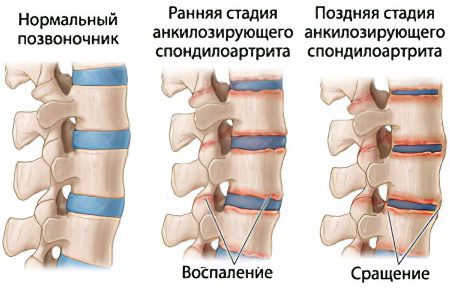
In about 10-20% of people, the pathology has a latent course and does not manifest itself in any way at an early stage of development.
In other cases, the disease is characterized by the following set of symptoms:
Pain in the region of the sacrum. It is the painful sensations of this localization that become the first signal of a developing pathology. Most often, the pain is concentrated on one side of the sacrum, but can radiate to the thigh and lower back.
Stiffness of the spine. It is especially noticeable in the morning, after sleep, or after a long pastime in one position. During the day, stiffness disappears, and it is also possible to get rid of it thanks to a warm-up. A distinctive characteristic of the pain and stiffness that occurs with ankylosing spondylitis is that these sensations increase at rest, and disappear after physical activity.
Chest pain. It occurs due to the fact that the rib-vertebral joints are affected. Pain intensifies when trying to take a deep breath, as well as during coughing. Sometimes people confuse such painful sensations with heart pain and with intercostal neuralgia. Doctors recommend that patients do not cut the depth of inspiration, do not switch to shallow breathing.
Deterioration of mood. Not all patients with Bechterew’s disease suffer from a breakdown and depression. Apathy develops only in some patients.
A pressing feeling in the chest. It appears due to the deterioration of the mobility of the ribs. People with ankylosing spondylitis switch to belly breathing.
Head drop. This symptom occurs due to the fact that the joints suffer, and the spinal column itself is deformed.
Restriction of mobility.
Late stage symptoms
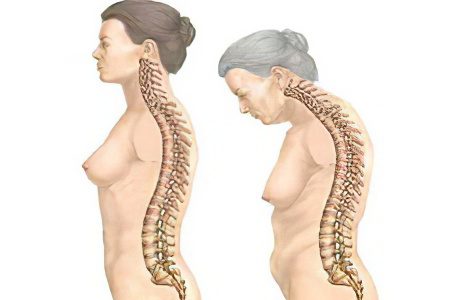
At a late stage of the development of the disease, a person has the following symptoms:
Signs of radiculitis. They are characterized by severe pain in the spine, numbness of the muscles, their tingling. In the affected area, tactile sensitivity decreases, muscles lose their tone, become weak and atrophy. Any physical activity leads to increased pain.
Violation of the blood supply to the brain. A person has headaches, they are dull, throbbing, most often concentrated in the occipital region. The patient suffers from dizziness and tinnitus, visual disturbances may occur. Deterioration of brain nutrition can be manifested by increased heart rate, hot flashes, sweating, irritability, weakness and increased fatigue.
Suffocation. Attacks occur due to the fact that the mobility of the chest worsens, pressure on the lungs increases, blood vessels are squeezed.
Increased blood pressure. This symptom develops due to the fact that the blood supply to the brain suffers, the load on the vessels and the heart increases.
Spinal deformity. His joints ossify, which leads to a deterioration in their mobility. The cervical region strongly arches forward, and the thoracic region back.
Symptoms of damage to other organs
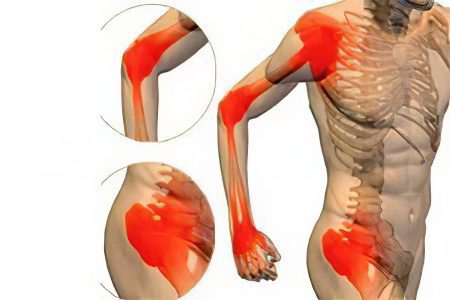
Depending on the form of the disease, the symptoms of ankylosing spondylitis will vary.
In the rhizomelic form, the hip joints suffer, so the symptoms of the pathology can be distinguished as follows:
Ossification of the spinal column.
Slow progression of pathological signs.
Pain in the region of the hip joints. On the one hand, they will hurt more.
Irradiation of pain in the thigh, groin, knees.
In the peripheral form of the disease, the knee and foot joints are affected.
The main signs of violation:
For a long time, only those symptoms that concern the spinal column bother a person.
Predominantly adolescents suffer from the peripheral form of the disease. The later the pathology develops in a person, the lower the risks of joint damage.
Pain is concentrated in the knees and ankle joints.
The joints are deformed, cease to perform their function normally.
The Scandinavian form of the disease is manifested by symptoms such as:
Damage to the small joints of the feet and hands.
Over time, the joints deform, their mobility worsens.
The clinic of the Scandinavian form of the disease resembles rheumatoid arthritis.
Causes of ankylosing spondylitis

Despite advances in modern medicine, the exact causes of Bechterew’s disease remain unknown.
Doctors only make assumptions about what pathology can develop due to:
Hereditary predisposition to the development of pathology. As observations show, Bechterew’s disease is transmitted from father to son in 89% of cases.
Transferred urogenital infections. The likelihood of developing Bechterew’s disease increases if the urogenital infection has a chronic course, and the person does not receive adequate therapy.
Decreased immunity. The reasons for the weakening of the body’s defenses can be very diverse. The weaker the immune system, the higher the likelihood of ankylosing spondylitis.
First, with Bechterew’s disease, the sacrum and iliac region are affected, and then the pathology spreads to other joints.
Diagnostics
To make a correct diagnosis, the patient will need to undergo a series of studies. Without a comprehensive diagnosis, it will not be possible to determine Bechterew’s disease.
Which doctor to contact?
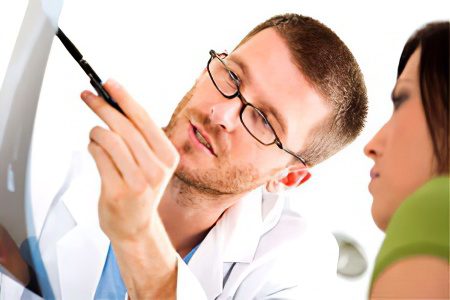
If a person has symptoms that may indicate ankylosing spondylitis, he needs to contact such specialists as:
Therapist. The doctor may suspect the disease to make a preliminary diagnosis. To clarify it, additional tests and visits to doctors of a narrower specialization will be required.
Vertebrologist. This doctor specializes in diseases of the spine.
Rheumatologist. This doctor treats rheumatism and other joint pathologies.
Orthopedist. The doctor of this specialty is engaged in the identification and treatment of diseases of the musculoskeletal system.
Instrumental and laboratory examination
To begin with, the doctor studies the patient’s history, performs an examination, palpates the spine and other joints, and assesses their mobility.
Investigations that need to be done to clarify the diagnosis:
Radiography of the spine.
MRI of the spine.
Donating blood for a general analysis. The patient will have an elevated ESR level and a positive DPA reaction, which indicates an inflammatory process in the body. In this case, the rheumatoid factor will be absent.
Blood test for HLA-B27 antigen. This study is carried out in controversial cases.
The most informative diagnostic methods are MRI and radiography.
Treatment of ankylosing spondylitis
It will not be possible to completely cure Bechterew’s disease. However, if the treatment was started on time, then it becomes possible to stop its progression, prevent the development of complications and immobilization of the patient. The patient is prescribed lifelong therapy, which should not be interrupted. The doctor will need to visit the system. Otherwise, the pathology will progress.
Non-drug treatment
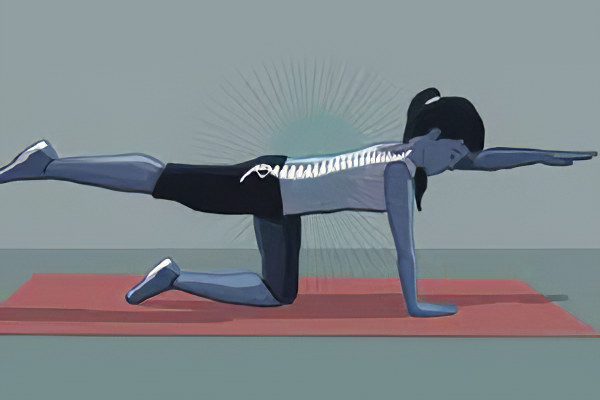
By itself, non-drug treatment will not allow to achieve a positive effect, but in combination with drug correction and kinesitherapy, the result will not be long in coming.
Methods that can be implemented in Bechterew’s disease:
Physiotherapeutic effect on the body. Patients can be shown magnetotherapy, ultrasound treatment, balneotherapy, taking bischofite, sodium chloride and hydrogen sulfide baths.
X-ray therapy. Such treatment involves the exposure of x-rays to the affected area.
Massage. It is indicated after reaching stable remission. It is necessary to influence the spine correctly, only a professional is allowed to perform the procedure. Otherwise, you can harm a person.
Exercise therapy. The patient should engage in adapted sports. The complex is made on an individual basis. Daily exercise will prevent tissue ossification and maintain the performance of the spinal column.
Kinesitherapy It is a treatment with breathing techniques and movement.
Doing exercises in the pool. Before you start swimming, you need to consult a doctor.
Performing gymnastic exercises on special suspensions.
Video: real life story:









